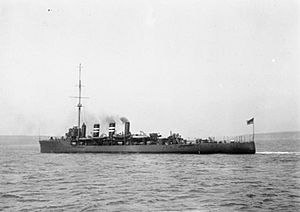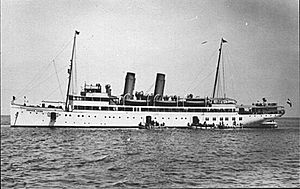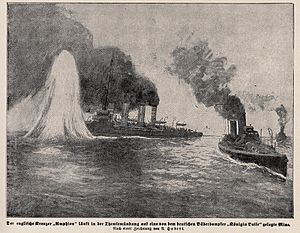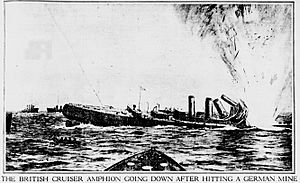HMS Amphion (1911) facts for kids

Amphion about 1914
|
|
Quick facts for kids History |
|
|---|---|
| Name | Amphion |
| Ordered | 1910 Naval Programme |
| Builder | Pembroke Dockyard |
| Laid down | 15 March 1911 |
| Launched | 4 December 1911 |
| Completed | March 1913 |
| Fate | Sunk by mine, 6 August 1914 |
| General characteristics (as built) | |
| Class and type | Active-class scout cruiser |
| Displacement | 3,340 long tons (3,390 t) (normal) |
| Length | 405 ft (123.4 m) (o/a) |
| Beam | 41 ft (12.5 m) |
| Draught | 14 ft 6 in (4.4 m) |
| Installed power | |
| Propulsion | 4 × shafts; 2 × steam turbine sets |
| Speed | 25 knots (46 km/h; 29 mph) |
| Range | 4,630 nmi (8,570 km; 5,330 mi) at 10 knots (19 km/h; 12 mph) |
| Complement | 293 |
| Armament |
|
| Armour |
|
HMS Amphion was a special type of warship called a scout cruiser. She was built for the Royal Navy (Britain's navy) just before World War I began. Completed in 1913, Amphion was designed to work closely with smaller, faster ships called destroyers. She would lead them into battle and support them.
In mid-1914, Amphion became a leader for a group of destroyers, known as a flotilla. When World War I started in August 1914, her flotilla was part of the Harwich Force. This group protected the eastern coast of England. On the very first day of the war, Amphion and her destroyers found and sank a German ship called SMS Königin Luise. This German ship was laying mines in the sea.
The next morning, on August 6, 1914, Amphion hit one of these mines near the Thames Estuary. The ship quickly sank, and 132 crew members lost their lives. Amphion was the very first ship of the Royal Navy to be sunk in World War I. Today, her wreck is a protected site, meaning you need special permission to dive there.
Contents
Understanding the Amphion Ship Design
The Active-class ships, like Amphion, were the last scout cruisers built with steam turbine engines for the British Navy. These ships were meant to help destroyer groups. They would lead torpedo attacks and back up destroyers if they were attacked. However, destroyers became much faster before World War I, making these scout cruisers less useful for their original role.
Amphion Dimensions and Crew
Amphion was about 405 feet (123.4 m) long. That's longer than a football field! She was 41 feet (12.5 m) wide and sat about 14 feet 6 inches (4.4 m) deep in the water. The ship weighed about 3,340 long tons (3,394 t) when fully loaded. Her crew usually had 289 officers and sailors.
Weapons and Protection of Amphion
Amphion had ten main guns, each 4-inch (102 mm) (about 10 cm) in size. Two guns were at the front of the ship, six were in the middle (three on each side), and two were at the back. These guns could fire shells weighing 31-pound (14 kg) (about 14 kg) up to 11,400 yards (10,400 m) (about 10.4 km).
For smaller threats, she also had four smaller 1.9 in (47 mm) (about 2-inch) guns. Plus, she carried two torpedo tubes that could launch 18 inches (457 mm) (450 mm) torpedoes from underwater.
Scout cruisers were built for speed, so they didn't have very thick armour. Amphion had a curved protective deck that was one inch (25 mm) thick on the sloped parts and 0.5 inches (13 mm) on the flat parts. Her conning tower, where the ship was controlled, had 4 in (102 mm) of armour.
Building and Service of HMS Amphion
Amphion was ordered in 1910. Her construction started at Pembroke Dockyard on March 15, 1911. She was officially launched into the water on December 4, 1911, by Mrs. Mundy. The ship was finished in March 1913. Her first commander was Captain Frederic Dreyer.
Amphion was officially put into service on April 2, 1913. She first joined the 4th Battle Squadron of the First Fleet. A month later, she moved to the 1st Light Cruiser Squadron. By June 1914, she was leading the 3rd Destroyer Flotilla.
First Battle of World War I
When World War I began in August 1914, Amphion and her flotilla were part of the Harwich Force. This group was led by Captain Cecil H. Fox. Their job was to protect the sea routes leading to the English Channel.
On the morning of August 5, Amphion and her destroyers sailed into the North Sea. They were looking for German ships between Harwich and the Dutch island of Terschelling. Around 10:15 AM, they saw a ship that looked like a British ferry. Captain Fox sent two destroyers, Lance and Landrail, to check it out. Soon, another destroyer reported that a trawler had seen a suspicious ship "throwing things overboard, presumably mines."
Amphion led her group to investigate. They saw the ship was indeed dropping mines into the sea. At 10:45 AM, the destroyer Lance opened fire.
The German Minelayer Königin Luise
The enemy ship was SMS Königin Luise. She used to be a passenger boat for tours in Germany. The Germans had turned her into a ship that laid mines. They planned to put bigger guns on her, but they didn't have time. So, she only had two small guns and 180 mines. On the night of August 4, she had left Germany to lay mines near the Thames Estuary. She started doing this at dawn.
The destroyers' shots didn't do much damage at first. But when Amphion got closer, she started hitting the German ship around 11:15 AM. By noon, Königin Luise was sinking. The British ships rescued 5 officers and 70 sailors from the German ship.
Amphion's Tragic End
After sinking Königin Luise, the British ships continued their patrol. They reached the Dutch coast around 9:00 PM and then turned back towards home. Captain Fox wasn't sure exactly where Königin Luise had laid her mines. He set a course about seven nautical miles (13 km; 8.1 mi) (13 km) west of where he thought the mines were. Unfortunately, he guessed wrong, and led his ships right over the dangerous area.
At 6:35 AM, Amphion hit a mine. The mine exploded right under her bridge. The explosion caused a fire at the front of the ship and broke the ship's main structure, called the keel. The destroyer Linnet tried to tow Amphion, but a large crack appeared across her upper deck. This showed she was badly damaged. Captain Fox ordered his crew to leave the ship.
Soon after, Amphion's front magazine (where ammunition was stored) exploded. One of her 4 inches (102 mm) guns was thrown into the air and just missed the Linnet. One of Amphions own shells exploded on the deck of another destroyer, Lark. This killed two of Larks sailors and the only German prisoner rescued from Königin Luise. Amphion then sank very quickly, within 15 minutes of the explosion. She lost 1 officer and 131 sailors. The wreck of Amphion is now a protected site under a special law.




